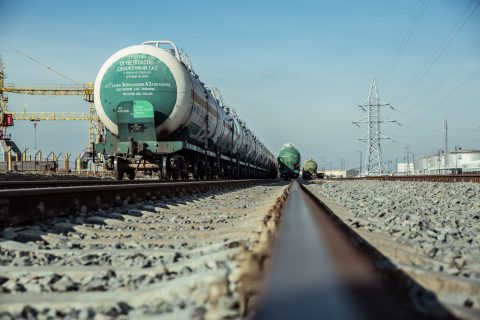One Belt, One Road, One Million on broad gauge track

‘One Belt, One Road, One Million’, is the current motto of UTLC regarding their practices on the New Silk Road. “We can handle one million TEUs, we have the capacity”, Larisa Kuznetsova said confident. The chief marketing officer of the company was one of the speakers in a session on Eurasian rail freight traffic at UIC’s Global Rail Freight Conference, which was held in Genoa from 26-28 June.
UTLC operates on the routes stretching from China to the EU, the broad gauge network as Kuznetsova named it. “On this 1520 mm gauge network, capacity is still available. Terminals still have reserve capacity. We are ready to handle more containers, and one million TEUs is our current target volume”, she urged.

Regular routes
At the moment, UTLC operate 51 regular routes between the continents. Their current focus is on the route via Kaliningrad, which provides a rail alternative, but also a multimodal solution for traffic to and from Europe. Through the Port of Kaliningrad, cargo can be forwarded to, for example, important Swedish and German ports, Kuznetsova reiterated.
From Kaliningrad cargo can be shipped over sea to the German ports of Hamburg, Rostock and Bremerhaven, or to the Swedish ports of Trelleborg, Goteborg and Stockholm, she explained. “To Hamburg the transit time is sixteen hours, to Rostock twenty hours and to Hamburg 36 hours. Kaliningrad is a new multimodal logistics hub at the EU border. Both through the maritime route and the overland route it can handle eight trains per day, and 300,000 TEU per year.”
Alternative routes
The Kaliningrad is an alternative route to the railway line via the busy border crossing between Poland and Belarus at Brest. As this border crossing is reaching its maximum capacity, operators search for other options in order to provide with fast transit of goods; an added value of the New Silk Road. Hence, routes are increasingly being developed via Slovakia and Ukraine.
However, as Uwe Leuschner, senior vice president business development Eurasia at DB Cargo pointed out, the side effect of such alternatives is that the transit through Russia becomes more expensive. “Russia is not willing to provide the best rates if we do not opt for the route through Brest.” He added: “There are some middlemen who just want to do business, and do not consider the interests of the route as a whole.”
Via Latvia
Meanwhile, Latvia is making a case for transit through its territory, which has the unique asset of providing 1520 mm gauge track but also the narrow gauge, connecting to the European network. “We have the potential to merge all the systems, and provide a link from China through Belarus to Europe”, said Edvīns Bērziņš, CEO VAS of Latvia Railways.
If the route is to gain popularity, Riga can become a true hub in the Baltic region. A multimodal logistics centre is in the making, facilitating railway on the west-east route, but also maritime routes to Scandinavia in the north and Europe and Turkey in the south, he explained. “This centre should become the intersection of different systems. I can assure that Latvia will be actively involved in Eurasian rail freight”, he pointed out.
You just read one of our premium articles free of charge
Want full access? Take advantage of our exclusive offer






